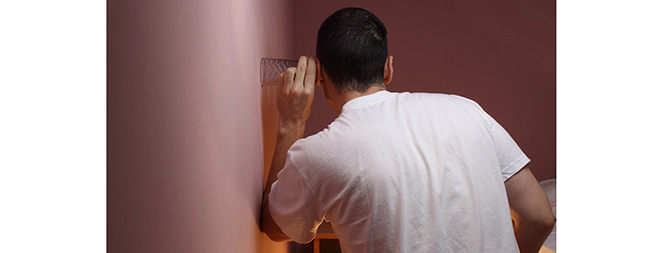Pinholes And Plastic Wrap Send Sound Through Walls
Common kitchen item erases wall's barrier to sound.
Image

Media credits
(ISNS) – A team of Japanese and South Korean researchers has devised a means of making solid walls virtually transparent to sound.
The process relies on drilling small holes in a rigid material, such as a wall, and covering them on one side by a membrane made from the plastic wrap found in any kitchen.
"The wall with the bare holes seriously hinders the transmission," the team reported in the June 13 issue of Physical Review Letters. "[B]ut with the membrane installed the transmission becomes, as expected, almost as good as with no wall."
Properly sized, spaced, and tuned, the setup allows the pressure waves responsible for sound to pass through the barrier. In experiments, the system transmitted sound between three-quarters and almost 100 percent of the volume of the original sound source, depending on the size of the holes.
The research has potential uses in creating security barriers that permit voice communication to pass through, and in developing types of sound-based microscopes that could find application in research laboratories and medical practice.
The development required significant advances in the theory and practice of sound transmission.
"It is indeed astonishing," said physicist Oliver Wright of Japan's Hokkaido University.
Wright collaborated on the research project with Sam Lee and colleagues at Yonsei University and Kong-Ju-Bock Lee of Ewha Womans University, both in South Korea.
"I am very excited by these results," said Johan Christensen, a photonic engineer at the Technical University of Denmark who has developed theoretical insights into this process. "The most striking thing they demonstrate is the possibility of squeezing a tremendous amount of sound through extremely small openings."
The approach the team employed resembles that used for an effect that physicists call extraordinary optical transmission, which was discovered by Thomas Ebbesen of the University of Strasbourg in France in 1998. In this, Wright explained that given the size and spread of holes drilled into a sheet, "tiny sub-wavelength holes in metals can allow more light through than expected."
Wright said that his team set out "to reproduce the results in audio acoustics." They set out to explore the idea that holes smaller than the wavelength of sound waves would permit more sound to pass through than expected.
Physicists had already tried to pass sound through solid walls by drilling holes in them, but struggled because the rigid parts of the wall reflected most of the sound under most conditions, Wright said.
The only way to allow high volumes of sound through the holes is to ensure that the sound waves travel much faster as they pass through the holes than they do before reaching them and after passing through them. Wright's team decided to do that by covering each hole with a membrane of plastic wrap, the same kind used to cover food.
The plastic film resonates in response to sound passing through each hole. As a result, Wright said, "the pressure on both sides of the hole becomes equal and the energy incident on one side of the wall is funneled through the small holes. This results in efficient transmission and no reflection."
In other words, holes covered by a membrane make walls effectively invisible to sound.
Why did the team choose plastic wrap as the membrane material?
"It is known to be a convenient material to make a membrane and, of course, it is readily available," Wright said. "Some first experiments were done with rubber membranes, but we found that [plastic wrap] provides a better transmission."
To test their setup, the researchers used loudspeakers to produce sound and direct it through a rigid wall containing holes. A microphone on the other side of the wall recorded the sound that passed through.
In various studies, the team recorded 76 percent, 89 percent, and 97 percent transmission of the volume of sound through the wall with holes covered with the plastic wrap. The percentage depended on the size of the holes in relation to the total area of the wall.
Scientists imagine two main types of use for the development.
"By the use of a wall with holes of varying size, one can make a security barrier for efficient oral communication in places like banks or taxis," Wright said. "By squeezing a lot of energy through a single hole, one could make a novel form of acoustic microscope."
Such an instrument could identify objects far smaller than the wavelength of the sound that impinges on them. It could have application in medical practice as well as research.
"If you focus sound to a spot much smaller than the wavelength," Christensen said, "you could be able to devise instruments to detect early-stage tumors, which are too small to observe by conventional ultrasound techniques."
Filed under

